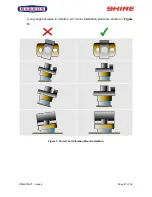
RDG603A27
– Issue 6
Page 32 of 59
18. Installation Check List
Please tick box
Engine alignment correct, clearance all round, check propeller turns by hand
(Ensure ignition is off battery and battery master switch is off)
Anti-Vibration mounts correct height, spacers if necessary. Make sure all nuts are
tight
Exhaust system as specified
Battery leads are of correct size, tightened and start battery is charged
Check tension of alternator belts, wiring connected and belt alignment checked if
removed
Check fuel system is connected correctly and primed
Fuel line water trap installed and water drained off
Check header tank connections are correct way round, constant pipework rise to
header tank
Check level of coolant in header tank or manifold and correct ratio of antifreeze to
water
All air has been bled from skin tank, calorifier and pipework
Engine and gearbox oil levels are as specified
Throttle and gear cables correctly adjusted and operating smoothly
All pipework and cabling supported and not chaffing, slack to allow movement of
engine
Engine control panel installed in a position where it is not out in the open
Confirm engine control panel, gauges and warning lights are all operational
Suitable specification of hose between seacock and seawater pump with no
restrictions is fitted
Run the engine for 20 minutes with the boat tied up and in gear (at ½ speed). Check
for leaks and that all systems operate correctly
Check & Set the Engine Idle Speed to 850-875 rpm
Check for leaks
Explain/Demonstrate daily/weekly/periodic maintenance checks
Explain/Demonstrate off season storage and maintenance
Travel Power 230v AC systems installed by qualified electrician and to BMEA code
of practice for Electrical and Electronic installation in Boats: BS EN ISO 13297 (ac)
Installer’s signature
Installer name/company
















































